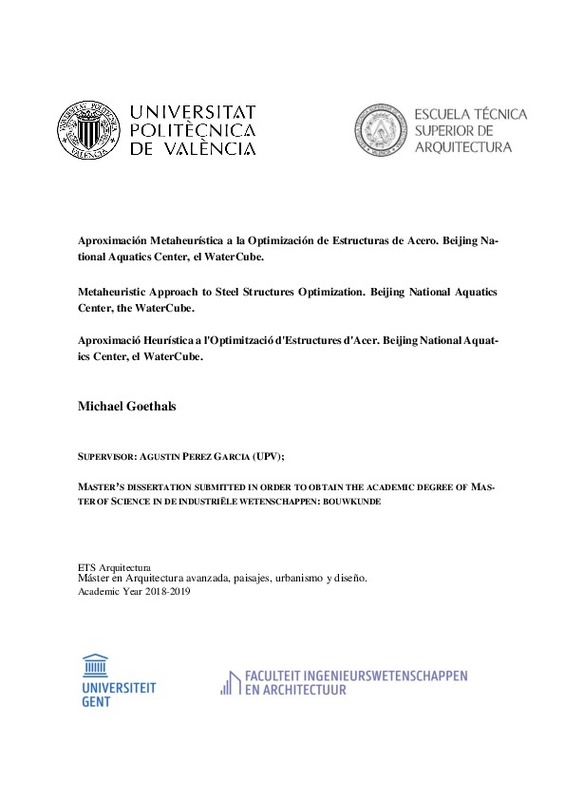JavaScript is disabled for your browser. Some features of this site may not work without it.
Buscar en RiuNet
Listar
Mi cuenta
Estadísticas
Ayuda RiuNet
Admin. UPV
Metaheuristic approach to steel structures optimization: Beijing National Aquatics Center, the Water Cube
Mostrar el registro sencillo del ítem
Ficheros en el ítem
| dc.contributor.advisor | Pérez García, Agustín José
|
es_ES |
| dc.contributor.author | Goethals, Michael
|
es_ES |
| dc.date.accessioned | 2019-10-03T13:00:40Z | |
| dc.date.available | 2019-10-03T13:00:40Z | |
| dc.date.created | 2019-06-18 | |
| dc.date.issued | 2019-10-03 | es_ES |
| dc.identifier.uri | http://hdl.handle.net/10251/127168 | |
| dc.description.abstract | [ES] Los algoritmos metaheurísticos se han aplicado durante décadas para optimizar muchos aspectos de las estructuras de ingeniería de edificios. Estos procedimientos de búsqueda frecuentemente involucran la simulación de procesos naturales para diseñar la estructura tan eficientemente como lo hace la Naturaleza. La técnica de optimización evolutiva más conocida y utilizada con más frecuencia, los algoritmos genéticos (AG), se inspiró en los principios de Darwin sobre selección natural, genética y evolución, y simula el comportamiento de reproducción observado en las poblaciones biológicas. La optimización de enjambre de partículas (PSO) es otro método de optimización estocástica motivado por el comportamiento social de la bandada de aves y la escolarización de peces. La optimización de colonias de hormigas (ACO) es una técnica de búsqueda cooperativa que imita el comportamiento de forrajeo de las colonias de hormigas de la vida real para establecer rápidamente la ruta más corta de una fuente de alimento a su nido y viceversa. El método de búsqueda de sistema cargado (CSS) utiliza las leyes vigentes de la física y la mecánica. Las leyes de electrostática y las leyes de mecánica newtoniana impulsan el proceso de búsqueda de la configuración óptima del sistema. Sin embargo, a veces la analogía se deriva de comportamientos o fenómenos humanos o sociales. El algoritmo de competencia imperialista (ACI) es un procedimiento motivado socio-políticamente que se aplica con frecuencia para resolver problemas de optimización estructural. El mapeo aéreo de vastos territorios (VTAM, por sus siglas en inglés) es un algoritmo inspirado en el levantamiento aéreo del paisaje con fines de caracterización orográfica. La tesis de máster se dedicará a la introducción de los enfoques metaheurísticos mencionados anteriormente y se aplicará para resolver casos prácticos relacionados con la optimización estructural de ingeniería de edificios. Cada estudio de caso se definirá específicamente para cada estudiante de máster, siendo el algoritmo VTAM (implementado en el grupo de cómputo de la Universitat Politècnica de València) la principal herramienta de investigación. En este caso, el edificio estudiado será el Beijing National Aquatics Center, conocido como el Water Cube. | es_ES |
| dc.description.abstract | [EN] Metaheuristic algorithms have been applied for decades to optimize many aspects of building engineering structures. These searching procedures frequently involve the simulation of natural processes in order to design the structure as efficiently as Nature does. The most well-known and frequently used evolutionary optimization technique, genetic algorithms (GAs), was inspired from Darwin s principles about natural selection, genetics and evolution, and mimics the reproduction behaviour observed in biological populations. Particle swarm optimization (PSO) is another stochastic optimization method motivated from the social behaviour of bird flocking and fish schooling. Ant colony optimization (ACO) is a cooperative search technique that mimics the foraging behaviour of real-life ant colonies to rapidly establish the shortest route from a food source to their nest and vice versa. Charged system search (CSS) method utilizes the governing laws of physics and mechanics. Electrostatics laws and Newtonian mechanics laws drive the searching process of the optimum configuration of the system. However, sometimes the analogy derives from human or social behaviours or phenomena. The imperialist competitive algorithm (ICA) is a socio-politically motivated procedure frequently applied to solve structural optimization problems. Vast territories aerial mapping (VTAM) is an algorithm inspired by the aerial survey of the landscape for orographic characterization purposes. The Master Thesis will be devoted to introducing the abovementioned metaheuristic approaches and will be applied to solve practical cases related to building engineering structural optimization. Each case study will be defined specifically for each master student, being the VTAM algorithm (implemented in the computation cluster of the Universitat Politècnica de València) the main research tool. In this case the building to be analysed will be the Beijing National Aquatics Center, el Water Cube. | es_ES |
| dc.format.extent | 86 | es_ES |
| dc.language | Inglés | es_ES |
| dc.publisher | Universitat Politècnica de València | es_ES |
| dc.rights | Reconocimiento (by) | es_ES |
| dc.subject | Optimización | es_ES |
| dc.subject | Estructuras | es_ES |
| dc.subject | Acero | es_ES |
| dc.subject | Heurística | es_ES |
| dc.subject | Optimisation | es_ES |
| dc.subject | Structures | es_ES |
| dc.subject | Steel | es_ES |
| dc.subject | Heuristic | es_ES |
| dc.subject.classification | MECANICA DE LOS MEDIOS CONTINUOS Y TEORIA DE ESTRUCTURAS | es_ES |
| dc.subject.other | Máster Universitario en Arquitectura Avanzada, Paisaje, Urbanismo y Diseño-Màster Universitari en Arquitectura Avançada, Paisatge, Urbanisme i Disseny | es_ES |
| dc.title | Metaheuristic approach to steel structures optimization: Beijing National Aquatics Center, the Water Cube | es_ES |
| dc.type | Tesis de máster | es_ES |
| dc.rights.accessRights | Abierto | es_ES |
| dc.description.bibliographicCitation | Goethals, M. (2019). Metaheuristic approach to steel structures optimization: Beijing National Aquatics Center, the Water Cube. http://hdl.handle.net/10251/127168 | es_ES |
| dc.description.accrualMethod | TFGM | es_ES |
| dc.relation.pasarela | TFGM\112126 | es_ES |
Este ítem aparece en la(s) siguiente(s) colección(ones)
-
ETSA - Trabajos académicos [4493]
Escuela Técnica Superior de Arquitectura






